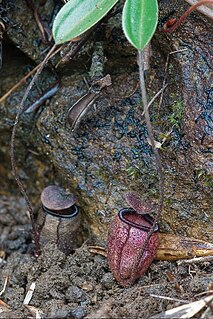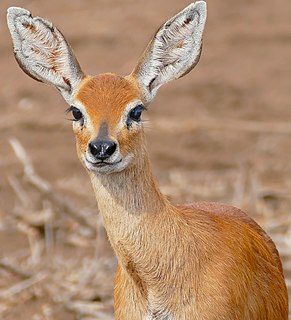
Ecology is a branch of biology concerning the spatial and temporal patterns of the distribution and abundance of organisms, including the causes and consequences. Topics of interest include the biodiversity, distribution, biomass, and populations of organisms, as well as cooperation and competition within and between species. Ecosystems are dynamically interacting systems of organisms, the communities they make up, and the non-living components of their environment. Ecosystem processes, such as primary production, pedogenesis, nutrient cycling, and niche construction, regulate the flux of energy and matter through an environment. These processes are sustained by organisms with specific life history traits.

Polyploidy is a condition in which the cells of an organism have more than two paired (homologous) sets of chromosomes. Most species whose cells have nuclei (eukaryotes) are diploid, meaning they have two sets of chromosomes—one set inherited from each parent. However, some organisms are polyploid, and polyploidy is especially common in plants. Most eukaryotes have diploid somatic cells, but produce haploid gametes by meiosis. A monoploid has only one set of chromosomes, and the term is usually only applied to cells or organisms that are normally haploid. Males of bees and other Hymenoptera, for example, are monoploid. Unlike animals, plants and multicellular algae have life cycles with two alternating multicellular generations. The gametophyte generation is haploid, and produces gametes by mitosis, the sporophyte generation is diploid and produces spores by meiosis.

Krill are small crustaceans of the order Euphausiacea, and are found in all the world's oceans. The name "krill" comes from the Norwegian word krill, meaning "small fry of fish", which is also often attributed to species of fish.

Homo is the genus that emerged in the genus Australopithecus that encompasses the extant species Homo sapiens, plus several extinct species classified as either ancestral to or closely related to modern humans, most notably Homo erectus and Homo neanderthalensis. The genus emerged with the appearance of Homo habilis just over 2 million years ago. Homo, together with the genus Paranthropus, is probably sister to Australopithecus africanus, which itself had previously split from the lineage of Pan, the chimpanzees.

The Actinomycetales are an order of Actinobacteria. A member of the order is often called an actinomycete.
The Thermotogae are a phylum of the domain Bacteria. The phylum Thermotogae is composed of Gram-negative staining, anaerobic, and mostly thermophilic and hyperthermophilic bacteria.

Nepenthes truncata is a tropical pitcher plant endemic to the Philippines. It is known from the islands of Dinagat, Leyte, and Mindanao. The species grows at an elevation of 0–1500 m above sea level. Nepenthes truncata is characterised by its heart-shaped (truncate) leaves and very large pitchers, which can reach up to 40 cm in height.

Nepenthes merrilliana is a tropical pitcher plant endemic to the Philippines. It produces some of the largest pitchers in the genus, rivalling those of N. rajah.

Nepenthes argentii is a highland Nepenthes pitcher plant native to Mount Guiting-Guiting on Sibuyan Island in the Philippines. It is possibly the smallest species in the genus and does not appear to have a climbing stage.

Johnston's genet is a genet species native to the Upper Guinean forests. As it is threatened by deforestation and conversion of rainforest to agriculturally and industrially used land, it is listed as Near Threatened on the IUCN Red List.

Raphicerus is a genus of small antelopes of the tribe Neotragini.

Schistura is a genus of fish in the stone loach family Nemacheilidae native to the streams and rivers of the southern and eastern Asia. Some of these species are troglobitic.

The big-headed turtle is a species of turtle in the family Platysternidae from Southeast Asia and southern China.
Erich Martin Hering was a German entomologist who specialised in leafmining insects, He was a curator in the Museum für Naturkunde in Berlin, where his collections of Lepidoptera, Coleoptera, Hymenoptera, Diptera are conserved. His collections of Agromyzidae are shared between MfN and the Agricultural School at Portici now part of the University of Naples Federico II.
In biology, a species is the basic unit of classification and a taxonomic rank of an organism, as well as a unit of biodiversity. A species is often defined as the largest group of organisms in which any two individuals of the appropriate sexes or mating types can produce fertile offspring, typically by sexual reproduction. Other ways of defining species include their karyotype, DNA sequence, morphology, behaviour or ecological niche. In addition, paleontologists use the concept of the chronospecies since fossil reproduction cannot be examined.

Bats are mammals of the order Chiroptera. With their forelimbs adapted as wings, they are the only mammals capable of true and sustained flight. Bats are more manoeuvrable than birds, flying with their very long spread-out digits covered with a thin membrane or patagium. The smallest bat, and arguably the smallest extant mammal, is Kitti's hog-nosed bat, which is 29–34 millimetres in length, 150 mm (6 in) across the wings and 2–2.6 g in mass. The largest bats are the flying foxes and the giant golden-crowned flying fox, Acerodon jubatus, which can weigh 1.6 kg and have a wingspan of 1.7 m.
Nitrospirae is a phylum of bacteria. It contains only one class, Nitrospira, which itself contains one order (Nitrospirales) and one family (Nitrospiraceae). It includes multiple genera, such as Nitrospira, the largest. The first member of this phylum, Nitrospira marina, was discovered in 1985. The second member, Nitrospira moscoviensis, was discovered in 1995.
Hyocephalidae are a small family of Heteroptera which are endemic to Australia.
Alfred Frank Millidge was a British arachnologist who wrote several works on spiders. One of his best-known might be British Spiders, volumes I and II, which he co-wrote with G. H. Locket. In 1983, he became the first person to describe the spider species Walckenaeria crocea.












